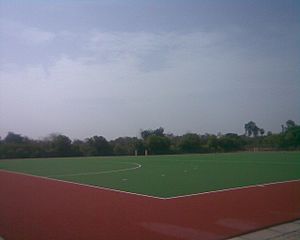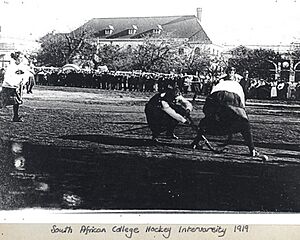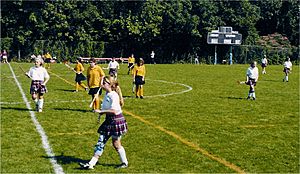History of field hockey facts for kids
Field hockey is a super old and popular sport! Some drawings found in an ancient Egyptian tomb, about 4000 years old, look a lot like people playing hockey. This suggests the game has been around for a very long time.
Hockey is especially popular in countries like India and Pakistan. People there played it for hundreds of years before countries like England helped make it into the modern game we know today. It's a bit like an old Scottish game called shinty. While hockey is often played in schools in the UK, its exact beginnings are a bit of a mystery. Later on, ice hockey developed in Canada, which is played on ice!
Contents
Hockey-like Games Around the World
Did you know that games similar to hockey were played in many different places, long ago?
Ancient Games in Asia
In Inner Mongolia, China, a group of people called the Daur people have played a game called Beikou for about 1,000 years. It's very much like modern field hockey!
Old Games in the Americas
When Europeans first came to Chile in the 1500s, they saw the Araucano people playing a game called chueca. This name means 'the twisted one', because of the bent stick players used. It was very similar to hockey.
Traditional Games in Australia and India
In Western Australia, early settlers saw the Noongar people playing dumbung. They used bent sticks to hit a ball made from dried sap of the native pear tree. This game is even thought to be where the town of Dumbleyung got its name!
In Punjab, India, there's a traditional game called khido khundi. This name roughly means "ball and blunt stick," and it's also a lot like hockey.
How Modern Hockey Began
Modern hockey started to take shape in England in the early 1800s.
Early English Hockey
In the early 19th century, a game called hockey was played in English public schools. An author named Lord Lytton wrote in 1853 that hockey was an "old-fashioned game, now very uncommon in England, except at schools."
At first, the game was quite rough. It was played on a very large field, and they used a black rubber cube instead of a ball. The sticks were also rough.
Teddington Hockey Club's Influence
The modern game we play today was mostly developed by Middlesex cricket clubs in London. These clubs were looking for a fun way to exercise in winter, but they didn't really like football.
Around 1870, members of the Teddington cricket club started experimenting with a "stick" game. They based it loosely on football rules. They played on their smooth cricket field and used a cricket ball, which made the game much smoother and more predictable.
By 1874, Teddington had started writing down rules for their game. They decided that players couldn't raise their sticks above shoulder height. They also said that a shot at goal had to be taken from inside a special circle in front of the goal. This circle is still used today!
Forming Associations and Spreading the Game
An early hockey association was formed in 1875, but it didn't last long. However, in 1886, the Hockey Association was created by seven London clubs. This association grew quickly.
The Teddington club decided that only eleven players should be on each team. They also introduced the idea of the "striking circle" (often called "the D"). They played many games in the winter of 1871. Other clubs soon formed in Richmond and Surbiton by 1874. They started playing matches against each other.
In the late 1800s, the game spread across the British Empire, largely thanks to the British Army. This led to the first international competition in 1895, where Ireland beat Wales 3-0.
Hockey at the Olympics
The International Rules Board was founded in 1895. Men's hockey first appeared at the Olympic Games in London in 1908. Only three teams played: England, Ireland, and Scotland. Men's hockey became a regular sport at the Olympics starting with the 1928 Games in Amsterdam.
The International Hockey Federation (FIH)
In 1924, the International Hockey Federation (FIH) was founded in Paris. This happened because hockey was not included in the 1924 Paris Games. The FIH was started by Paul Léautey from France. Its first members included Austria, Belgium, Czechoslovakia, France, Hungary, Spain, and Switzerland.
The game was brought to India by British soldiers. The first clubs there started in Calcutta in 1885. India became incredibly strong in hockey. They won all five of their games without letting in a single goal at the 1928 Olympics. India continued to win Olympic gold medals from 1932 to 1956, and again in 1964 and 1980. Pakistan also won gold in 1960, 1968, and 1984.
Women's Hockey
Women's hockey grew separately from men's hockey for a while. Women didn't seem to play hockey much before modern times.
Early Women's Clubs
Women's hockey was first played at British universities and schools. The very first women's club, Molesey Ladies Hockey Club, was founded in 1887. The first national association for women was the Irish Ladies Hockey Union in 1894. Even though the main Hockey Association didn't support them at first, women's hockey quickly became popular around the world.
This led to the creation of the International Federation of Women's Hockey Associations (IFWHA) in 1927. The IFWHA held conferences every three years, and these events included their main competitions. Interestingly, these tournaments were not competitive until 1975.
Merging of Associations
By the early 1970s, there were many women's hockey groups. Some were part of the FIH, and others were in the IFWHA. They started talking about having one set of rules for everyone.
The FIH began holding competitive tournaments in 1974. This encouraged the IFWHA to accept competitive hockey in 1973. It took until 1982 for the two groups to finally merge. This merger allowed women's hockey to be included in the 1980 Olympic Games. Since then, teams like Australia, Germany, and the Netherlands have been very strong in women's hockey, just like in the men's game.
The Synthetic Revolution

In the early 1970s, a big change happened in hockey: "synthetic grass" fields started to be used. The first Olympic Games played on this new surface were the 1976 Montreal Games.
Impact of Artificial Surfaces
Now, synthetic pitches are required for all international tournaments and most national competitions. While some local games are still played on grass, synthetic turf has replaced it almost everywhere in the western world.
Using artificial surfaces completely changed the game. Players developed new tactics and techniques, like the Indian dribble, to suit the new surface. New rules were also added to control these new ways of playing.
Changes in Equipment
Hockey sticks also changed. The bent part at the bottom, which used to be about 15 centimeters long, became much shorter and stubbier. This is because the ball travels much straighter on the flatter synthetic fields, so the extra length wasn't needed.
Shorter sticks made it easier to play the ball with the "backhand" (hitting the ball with the other side of the stick). This made quick moves much faster. It also made it possible to stop the ball by placing the entire stick flat on the ground. This stopping technique is now used all the time for penalty corners. Sticks also became stiffer, allowing players to hit the ball harder.
New materials like fiberglass, carbon fiber, and kevlar were added to the traditional wooden sticks in the early 1970s. Sticks with an aluminium core were made but are now banned because they can be dangerous if they break. Wooden sticks are less common now, as most players use sticks made entirely of synthetic composite materials.
Goalkeeper equipment also improved. It became much better at resisting the strong shots from these new sticks. Helmets became a must-have, and padding became thicker and better at absorbing hits. This new equipment is very expensive for clubs and goalies to buy.
The hockey ball itself changed too. It used to be a leather ball with a seam, like a cricket ball. Now, it's a seamless, usually dimpled, hard plastic ball. These plastic balls are cheaper, last longer, behave more consistently, and aren't affected by water. This is important for elite-level hockey, which often uses water-covered synthetic fields.
Other player equipment changed as well. The studded boots used for grass fields are banned on synthetics. Players now use special boots designed for synthetic turf. Shin guards have better padding. Many players wear padded gloves, especially on their left hand, to protect against hits and to slide their hand on the turf without injury. Finally, wearing mouthguards to protect teeth is now required for safety in many countries.
Rules of the Game
The rules of hockey have changed a lot over time. The main reasons for these changes were:
- To make the game work well on the new synthetic fields that came out in the 1980s.
- To make the game easier for people who don't play to understand, so more people would watch it on TV.
Some important rule changes include:
- The FIH removed the offside rule (which was similar to offside in football) in the mid-1990s. This was done to create more chances for scoring goals.
- Rules for the penalty corner have been changed many times. This was to make it less important in the game and easier to understand for viewers.
- The amount of "bow" (curve) allowed in sticks was limited. This was to control the increasing use and power of drag flicks.



